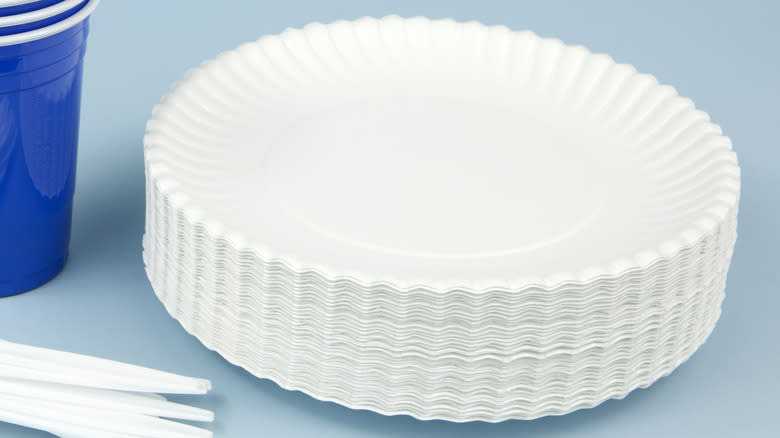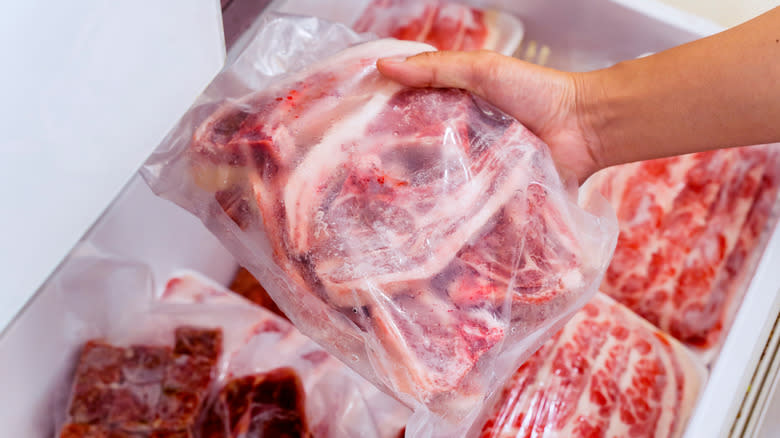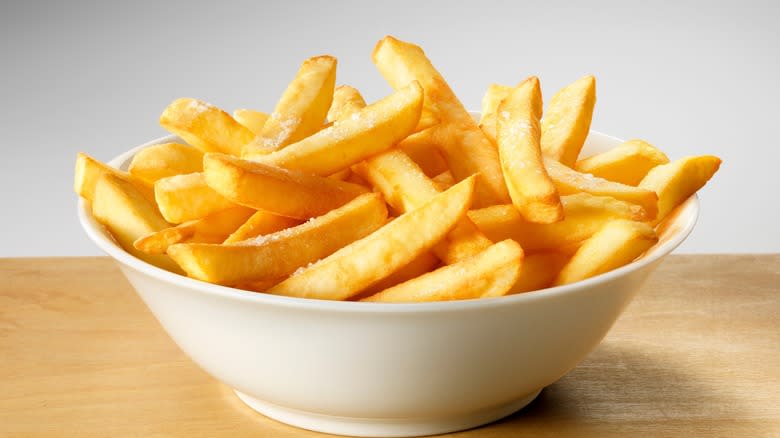18 Items You Should Never Put In The Microwave

Since the microwave oven was first introduced for residential use in 1967, it has become an appliance of unparalleled convenience. Nowadays, you can hardly find a household that dares to go without one. The microwave is frequently used to reheat leftovers for lunch or dinner the next day, not to mention a wide range of frozen foods and TV dinners (actually, let's not mention them). It's even possible to use a microwave to cook a whole range of tasty meals worthy of a Michelin-starred chef. One fan of microwave cooking is David Chang, head of the Momofuku restaurant empire; he prepares bacon, chicken legs, mussels, and more in the microwave.
That said, there are plenty of items you should definitely not be putting in your microwave. You may be aware that certain substances, like metals, can cause sparks to fly in microwaves, while other materials, such as plastic, might melt into your food. But there are also certain ingredients and drinks you should keep away from this appliance, not because they might start a fire, but because they could be damaged by the microwave-cooking process. So, let's take a look at some of these items and examine which ones you should avoid heating in your microwave at all costs.
Read more: 30 Popular Frozen Pizzas, Ranked Worst To Best
Tomato Sauce

If you make your own tomato sauce, chances are that you don't prepare a single portion of it each time. It's a lot more work to chop onions and garlic before standing around to stir the sauce to perfection than it is to pour it out of a store-bought jar, so it makes much more sense to prepare homemade sauce in large batches. The thing is, that leads to leftover sauce, which then needs to be heated up the next time you plan on using it.
That is all well and good, as long as you're aware that you shouldn't reheat tomato sauce in the microwave. Tomato sauce heats up especially fast, causing bubbles to build up pressure under the surface of the sauce. Those bubbles will eventually burst, causing the sauce to splatter all over the microwave or your crisp white shirt. Instead, just use a saucepan. By keeping the heat on a lower setting, you'll be able to control the heating process of the sauce and intervene before things get out of hand.
Steak

Nothing can beat a fresh steak straight off the grill. Whether you're dealing with a sophisticated filet mignon or a hearty tomahawk, few culinary experiences are more satisfying than biting into a perfectly cooked chunk of good beef. Thing is, steak is also very filling, and it's not uncommon for a person to be unable to finish their entire steak in one sitting, especially if it comes with sides. So what to do in these situations? Is it acceptable to just throw away leftover steak?
Absolutely not. However, you should know that when you do retrieve your steak the following day, you should be careful about how to heat it up. More specifically, don't reheat steak in the microwave. This appliance is not the best at heating foods evenly, which means that your steak may be left with pockets of cold meat interspersed with scalding hot bites. Meanwhile, the microwave will surely do away with the crispy crust on your steak while drying up the moist interior. Instead, use your stovetop or oven to preserve the flavors and textures of your leftover steak to the greatest possible extent.
Styrofoam Containers

Regardless of what you choose to heat up in a microwave oven, you should know about the types of containers you should never use to reheat food in your microwave. For instance, if you have some leftover takeout items in a foam container, you shouldn't skip the extra step of transferring that food to a microwave-safe vessel before nuking it.
That's because it's inadvisable to heat up foam containers in any way. They're typically composed of styrene, which, when heated, can bleed into your food. That can become a major health problem, since styrene has been linked to cancer. That said, some foam containers have a microwave-safe label, so they should be all right to heat — but be sure to check for this before you proceed.
Chicken

What's the use of a microwave if you can't use it to heat up chicken, one of the most common items on many household menus? Well, the thing is, you can use it without any unsafe consequences, so long as you don't mind eating dry and rubbery chicken. So, you'll want to think twice before reheating chicken in the microwave, depending on what's more important at the moment: convenience or quality.
If quality wins out, it may interest you to note that due to the high moisture content in chicken, the microwave is able to heat it up so fast that the water content evaporates and the meat's molecular structure changes, resulting in a less-than-satisfying new texture. Instead, reheat your chicken slowly on the stovetop with a little water or broth so that the meat doesn't dry out.
Hot Dogs

You may already know that you shouldn't put metal objects in a microwave. This causes sparks to fly, and may start a fire inside the appliance. But did you know that you should never microwave a hot dog, because frankfurters may spark a similar effect when heated this way? That's not because they contain metal (although with hot dogs, that has happened before), but because of a phenomenon called arcing, in which the salts and additives in the hot dogs can ignite sparks.
Given this potential risk, it's best to cook hot dogs in boiling water or on the grill, as good ol' American tradition would have it. However, if learning about this arcing phenomenon has worried you, we wouldn't blame you if you never wanted to eat hot dogs again!
Coffee And Tea

We've all made a nice, fresh pot of coffee only to get ensconced in our work and forget the java's there, until it has gone completely cold. Those are the times we may think a microwave might come in handy to heat it up again. That would be wrong.
As sad as it may be to throw away that coffee, it's pretty much done for if you let it go cold. That's because reheating coffee in a microwave interferes with its chemical composition, and turns it unpalatably bitter. If wasting anything really isn't your thing, it's best to lean into your mistake and turn the drink into an iced coffee.
Likewise, it's best not to heat water for tea in the microwave, but for different reasons. Tea is composed of delicate plant matter, and different types of teas require different water temperatures to thrive. For instance, green and white teas should be brewed in water that is between 175-180 degrees Fahrenheit, while water for black tea should be 212 degrees Fahrenheit. When you're using a microwave to get water to these temperatures, it's going to be hard to gauge when the water is ready. Instead, heat your water in a kettle and use a thermometer for good measure.
Metal

It is common knowledge that metal should not be heated in the microwave, but it still bears mentioning, especially so that we can explain what happens if your fork is microwaved by accident. While foods absorb the microwaves emitted inside the device to heat it, metal does not. Instead, it reflects these waves, causing electrons to fly in unpredictable ways and generate sparks.
Moreover, the smaller the amount of metal, or the thinner the layer, the more sparks you're going to get. These metal objects heat up faster, which means they react faster. This is why you may have been able to inadvertently heat a spoon (which is fairly thick all around) in the microwave, but not a fork, as the latter utensil's tapered tines are thin enough to quickly generate sparks.
Paper Plates

You may think that a paper plate would be safer than metal containers or styrofoam when microwaving your food. But safer is a relative term, and while paper is better than those other materials, it's still not ideal.
There are a number of reasons why it may be dangerous to microwave a paper plate. First, paper plates are rarely made only of paper. Those with a shiny coating on top likely contain some plastic, which could seep into your food when heated. Another substance that could seep in is the coloring used on decorated paper plates. And paper plates have been known to catch fire in the microwave after being left there for too long. While the USDA says that in most cases it's safe to microwave paper plates, these elements should be taken into consideration.
Frozen Foods

You've had a choice cut of steak sitting in your freezer just waiting to be taken out and enjoyed for a weeknight meal. The only problem is that you forgot to take it out to thaw when you left for work in the morning. Now it's 6 p.m., and that steak is still hard as stone. So your first thought might be to pop the meat in the microwave and hit the defrost button.
That would be one of the biggest mistakes people make when defrosting meat. Despite the dedicated function, microwaves are not very good at defrosting frozen meat. They don't heat it evenly, and the parts that they do heat can reach temperatures that favor the growth of bacteria, which in turn forces you to cook the meat thoroughly instead of going for rare or medium-rare. The texture of the meat can also be affected, causing it to become chewy and tough.
Leftover Potatoes

Cooking potatoes in the microwave can be a quick and easy way to prepare a weeknight dinner, and there's no reason you can't continue that tradition. But once they've been cooked, you shouldn't microwave leftover potatoes. Already-cooked potatoes that haven't been properly stored can contain bacteria that cause botulism, a dangerous disease that can be deadly. When you pop contaminated potatoes in the microwave, the bacteria can survive being nuked.
The best way to deal with this problem is to make sure your potatoes go into the fridge as soon as possible after first being cooked. The longer they're left out, the more time they have for the bacteria to develop. When it's time to reheat them, use the oven or an air fryer.
Dutch Oven

A Dutch oven, which tends to come with its own lid, may seem like it would be a convenient vessel for microwaving food. Perhaps you've been keeping some leftover soup in there and want to reheat it in the microwave with the lid on, so the soup doesn't splatter everywhere.
But before you do that, stop. A Dutch oven is the one kitchen item that you should absolutely never put in the microwave. As colorful as some may be, Dutch ovens are actually made of metal, making them a definite microwave no-no. Indeed, Dutch ovens are made of cast iron, which also explains why they're so heavy. Placing a Dutch oven in the microwave is not only dangerous, it also won't cook your food, because the microwaves won't be able to penetrate the metal exterior.
Bread

Dry and chewy microwaved bread will probably not harm your health or your microwave in any way, but is dry and chewy bread really something you'd want to eat? Although you may see your bread heat up and soften in the microwave, as soon as it cools down again, it'll become hard and chewy before you even have time to put it in your mouth. This happens because the sugar particles in bread melt at high heat, but then immediately recrystallize as it cools.
The best way to heat up bread is in the toaster, hands down. This will heat the bread to a crispy texture while leaving it soft on the inside. If you don't have a toaster, the oven will produce a similar effect, or you can heat up bread slices in a pan, flipping them before they burn.
Fried Foods

One of the joys of fried foods is their crispy, crunchy exterior. Whether you're dealing with fries or fried chicken, this textural element is what makes this type of food so enjoyable. But fried items rank high among foods you should never reheat in the microwave, because their delightfully crispy textures will transform into something limp and soggy. Even if the flavor manages to remain intact, this new texture makes the food less than desirable.
So, next time you need to heat up some fries or fried chicken, skip the microwave and toss them in a dry pan, or briefly bake them in the oven instead. If you have an air fryer, that's even better, as it can keep the crunchiness intact and warm the item almost as quickly as a microwave can heat up food.
Hot Peppers

When heated in the microwave, many hot peppers won't cause much of a stir. Jalapeños and other relatively mild peppers aren't strong enough to spread their heat, unless you're biting right into them. But the same can't be said for truly hot peppers, like the infamous Carolina Reapers or Scotch Bonnets. And definitely stay away from Pepper X, which in 2023 earned the title of the hottest pepper in the world.
The levels of capsaicin (the compound that gives peppers their heat) are so high in these chilies that the ingredient can spread through the air when heated in the microwave, getting into your eyes, nose, and throat and causing significant respiratory discomfort. The effect is similar to what happens when you pepper-spray someone — indeed, capsaicin is the active ingredient in pepper spray.
Compostable Containers

Compostable containers come with many benefits, but microwavable convenience is not one of them. That's because many of these food-storage vessels are coated with some form of plastic to make them waterproof. This plastic can then melt into your food when heated, and although many of these containers are made with natural ingredients, they're still not considered to be edible.
The safest thing to do is transfer your leftovers from the compostable container to a microwave-safe vessel, and toss the container where it belongs — the compost heap. Despite the presence of plastic, it will break down quickly. Just make sure that you take these containers to an appropriate composting facility, since biodegradable and compostable plastics are only guaranteed to break down under specific conditions.
Brown Paper Bags

A brown paper bag may seem like an innocuous product, and you might think nothing of heating it in a microwave with yesterday's pastry inside. But remember that microwaves are built to produce heat — and paper bags can quickly turn into fire hazards, especially when they're extremely dry.
Not only will the quickly rising heat transform paper bags into kindling, but paper bags are often made of more than just paper. They can contain chemicals that will inevitably be released through the heating process, and seep into your food and the air around it. That said, look for the "microwave safe" label on your paper bag. There is such a thing, and it might just be on the bag you're about to use, in which case, you're good to go.
Processed Meat

Processed meats like cold cuts are not the safest thing to eat, whether heated or not. The preservatives contained in them, such as sodium nitrite, can turn into nitrosamine compounds when heated, which have been linked to certain types of cancer.
As if that weren't bad enough, you should think twice before microwaving lunch meat. Cooking processed meats in a microwave can cause increased formation of cholesterol oxidation products, which can result in damage to arterial cells and exacerbate the risk of developing heart disease. While any form of heat can cause these effects in processed meats, with all this in mind, probably the safest thing to do is to avoid these foods entirely.
Plastic

Heating food in the microwave might not be as simple as you've always thought. While the process is quick and easy, there's also the matter of the container to think about — that is, what vessel is going to contain the food to be heated?
The answer to this may seem simple. There are plenty of products out there that are labeled microwave safe. But can they all be trusted? Apparently not. What microwave-safe plastic really means is that the container itself is safe to be heated up, not that you will be safe when you eat food from that container. The risk to you is that the microplastics and chemicals in that "microwave-safe" plastic container will leach into your food and cause associated health concerns. For instance, plastic-associated chemicals have been linked to heart disease, obesity, and diabetes.
Static Media owns and operates Tasting Table, Mashed, and Food Republic.
Read the original article on Tasting Table

